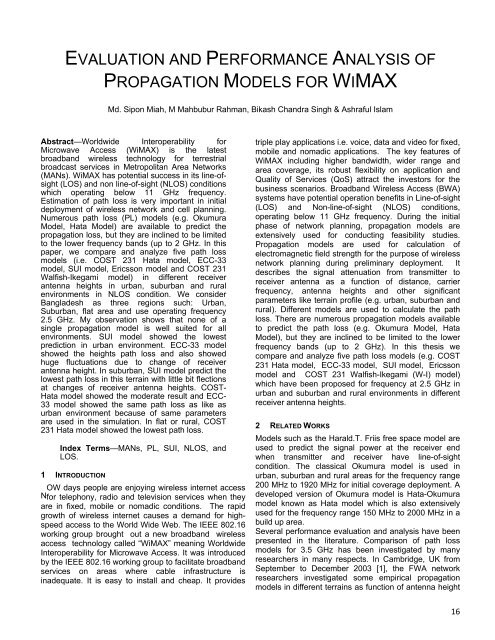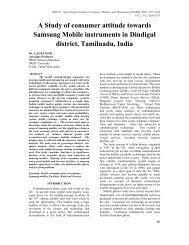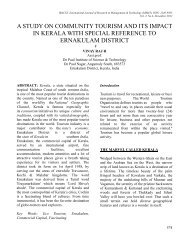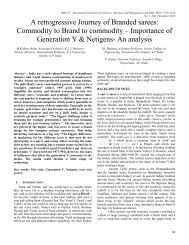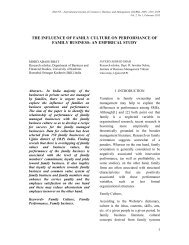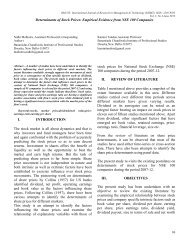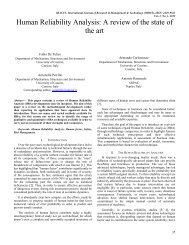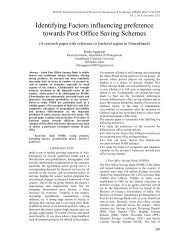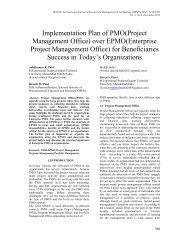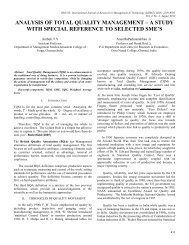evaluation and performance analysis of propagation models for wimax
evaluation and performance analysis of propagation models for wimax
evaluation and performance analysis of propagation models for wimax
Create successful ePaper yourself
Turn your PDF publications into a flip-book with our unique Google optimized e-Paper software.
EVALUATION AND PERFORMANCE ANALYSIS OFPROPAGATION MODELS FOR WIMAXMd. Sipon Miah, M Mahbubur Rahman, Bikash Ch<strong>and</strong>ra Singh & Ashraful IslamAbstract—Worldwide Interoperability <strong>for</strong>Microwave Access (WiMAX) is the latestbroadb<strong>and</strong> wireless technology <strong>for</strong> terrestrialbroadcast services in Metropolitan Area Networks(MANs). WiMAX has potential success in its line-<strong>of</strong>sight(LOS) <strong>and</strong> non line-<strong>of</strong>-sight (NLOS) conditionswhich operating below 11 GHz frequency.Estimation <strong>of</strong> path loss is very important in initialdeployment <strong>of</strong> wireless network <strong>and</strong> cell planning.Numerous path loss (PL) <strong>models</strong> (e.g. OkumuraModel, Hata Model) are available to predict the<strong>propagation</strong> loss, but they are inclined to be limitedto the lower frequency b<strong>and</strong>s (up to 2 GHz. In thispaper, we compare <strong>and</strong> analyze five path loss<strong>models</strong> (i.e. COST 231 Hata model, ECC-33model, SUI model, Ericsson model <strong>and</strong> COST 231Walfish-Ikegami model) in different receiverantenna heights in urban, suburban <strong>and</strong> ruralenvironments in NLOS condition. We considerBangladesh as three regions such: Urban,Suburban, flat area <strong>and</strong> use operating frequency2.5 GHz. My observation shows that none <strong>of</strong> asingle <strong>propagation</strong> model is well suited <strong>for</strong> allenvironments. SUI model showed the lowestprediction in urban environment. ECC-33 <strong>models</strong>howed the heights path loss <strong>and</strong> also showedhuge fluctuations due to change <strong>of</strong> receiverantenna height. In suburban, SUI model predict thelowest path loss in this terrain with little bit flectionsat changes <strong>of</strong> receiver antenna heights. COST-Hata model showed the moderate result <strong>and</strong> ECC-33 model showed the same path loss as like asurban environment because <strong>of</strong> same parametersare used in the simulation. In flat or rural, COST231 Hata model showed the lowest path loss.Index Terms—MANs, PL, SUI, NLOS, <strong>and</strong>LOS.1 INTRODUCTIONOW days people are enjoying wireless internet accessN <strong>for</strong> telephony, radio <strong>and</strong> television services when theyare in fixed, mobile or nomadic conditions. The rapidgrowth <strong>of</strong> wireless internet causes a dem<strong>and</strong> <strong>for</strong> highspeedaccess to the World Wide Web. The IEEE 802.16working group brought out a new broadb<strong>and</strong> wirelessaccess technology called “WiMAX” meaning WorldwideInteroperability <strong>for</strong> Microwave Access. It was introducedby the IEEE 802.16 working group to facilitate broadb<strong>and</strong>services on areas where cable infrastructure isinadequate. It is easy to install <strong>and</strong> cheap. It providestriple play applications i.e. voice, data <strong>and</strong> video <strong>for</strong> fixed,mobile <strong>and</strong> nomadic applications. The key features <strong>of</strong>WiMAX including higher b<strong>and</strong>width, wider range <strong>and</strong>area coverage, its robust flexibility on application <strong>and</strong>Quality <strong>of</strong> Services (QoS) attract the investors <strong>for</strong> thebusiness scenarios. Broadb<strong>and</strong> Wireless Access (BWA)systems have potential operation benefits in Line-<strong>of</strong>-sight(LOS) <strong>and</strong> Non-line-<strong>of</strong>-sight (NLOS) conditions,operating below 11 GHz frequency. During the initialphase <strong>of</strong> network planning, <strong>propagation</strong> <strong>models</strong> areextensively used <strong>for</strong> conducting feasibility studies.Propagation <strong>models</strong> are used <strong>for</strong> calculation <strong>of</strong>electromagnetic field strength <strong>for</strong> the purpose <strong>of</strong> wirelessnetwork planning during preliminary deployment. Itdescribes the signal attenuation from transmitter toreceiver antenna as a function <strong>of</strong> distance, carrierfrequency, antenna heights <strong>and</strong> other significantparameters like terrain pr<strong>of</strong>ile (e.g. urban, suburban <strong>and</strong>rural). Different <strong>models</strong> are used to calculate the pathloss. There are numerous <strong>propagation</strong> <strong>models</strong> availableto predict the path loss (e.g. Okumura Model, HataModel), but they are inclined to be limited to the lowerfrequency b<strong>and</strong>s (up to 2 GHz). In this thesis wecompare <strong>and</strong> analyze five path loss <strong>models</strong> (e.g. COST231 Hata model, ECC-33 model, SUI model, Ericssonmodel <strong>and</strong> COST 231 Walfish-Ikegami (W-I) model)which have been proposed <strong>for</strong> frequency at 2.5 GHz inurban <strong>and</strong> suburban <strong>and</strong> rural environments in differentreceiver antenna heights.2 RELATED WORKSModels such as the Harald.T. Friis free space model areused to predict the signal power at the receiver endwhen transmitter <strong>and</strong> receiver have line-<strong>of</strong>-sightcondition. The classical Okumura model is used inurban, suburban <strong>and</strong> rural areas <strong>for</strong> the frequency range200 MHz to 1920 MHz <strong>for</strong> initial coverage deployment. Adeveloped version <strong>of</strong> Okumura model is Hata-Okumuramodel known as Hata model which is also extensivelyused <strong>for</strong> the frequency range 150 MHz to 2000 MHz in abuild up area.Several <strong>per<strong>for</strong>mance</strong> <strong>evaluation</strong> <strong>and</strong> <strong>analysis</strong> have beenpresented in the literature. Comparison <strong>of</strong> path loss<strong>models</strong> <strong>for</strong> 3.5 GHz has been investigated by manyresearchers in many respects. In Cambridge, UK fromSeptember to December 2003 [1], the FWA networkresearchers investigated some empirical <strong>propagation</strong><strong>models</strong> in different terrains as function <strong>of</strong> antenna height16
The Hata model is introduced as a mathematicalexpression to mitigate the best fit <strong>of</strong> the graphical dataprovided by the classical Okumura model. Hata model isused <strong>for</strong> the frequency range <strong>of</strong> 150 MHz to 1500 MHz topredict the median path loss <strong>for</strong> the distance d fromtransmitter to receiver antenna up to 20 km, <strong>and</strong>transmitter antenna height is considered 30 m to 200 m<strong>and</strong> receiver antenna height is 1 m to 10 m. To predictthe path loss in the frequency range 1500 MHz to 2000MHz. COST 231 Hata model is initiated as an extension<strong>of</strong> Hata model. The basic path loss equation <strong>for</strong> thisCOST-231 Hata Model can be expressed as:PL = 46.3 + 33.9 log 10 (f) – 13.82 log 10 (h b ) – ah m + (44.9– 6.55 log 10 (h b )) log 10 d + c m6whered : Distance between transmitter <strong>and</strong> receiver antenna[km]f : Frequency [MHz]h b : Transmitter antenna height [m]The parameter c m has different values <strong>for</strong> differentenvironments like 0 dB <strong>for</strong> suburban <strong>and</strong> 3 dB <strong>for</strong> urbanareas <strong>and</strong> the remaining parameter ah m is defined inurban areas as:ah m = 3.20(log 10 (11.75h r )) 2 – 4.79 <strong>for</strong> f > 400 MHz7The value <strong>for</strong> ah m in suburban <strong>and</strong> rural (flat) areas isgiven as:IRACST - International Journal <strong>of</strong> Advanced Computing, Engineering <strong>and</strong> Application (IJACEA),Vol. 1, No.1, 2012: Wavelength [m]: Correction <strong>for</strong> frequency above 2 GHz [MHz]: Correction <strong>for</strong> receiving antenna height [m]: Correction <strong>for</strong> shadowing [dB]: Path loss exponentThe r<strong>and</strong>om variables are taken through a statisticalprocedure as the path loss exponent γ <strong>and</strong> the weakfading st<strong>and</strong>ard deviation s is defined. The log normallydistributed factor s, <strong>for</strong> shadow fading because <strong>of</strong> trees<strong>and</strong> other clutter on a <strong>propagation</strong>s path <strong>and</strong> its value isbetween 8.2 dB <strong>and</strong> 10.6 dB. The parameter A is definedasAnd the path loss exponent γ is given by10+ 11Where, the parameter h b is the base station antennaheight in meters. This is between 10 m <strong>and</strong> 80 m. Theconstants a, b, <strong>and</strong> c depend upon the types <strong>of</strong> terrain,that are given in Table 3. The value <strong>of</strong> parameter γ = 2<strong>for</strong> free space <strong>propagation</strong> in an urban area, 3 < γ < 5 <strong>for</strong>urban NLOS environment, <strong>and</strong> γ > 5 <strong>for</strong> indoor<strong>propagation</strong>.The frequency correction factor <strong>and</strong> the correction <strong>for</strong>receiver antenna height <strong>for</strong> the model are expressedinah m = (1.11log 10 f – 0.7)h r – (1.5 log 10 f – 0.8)8Where theis the receiver antenna height in meter.4.5 Stan<strong>for</strong>d University Interim (SUI) ModelIEEE 802.16 Broadb<strong>and</strong> Wireless Access working groupproposed the st<strong>and</strong>ards <strong>for</strong> the frequency b<strong>and</strong> below 11GHz containing the channel model developed byStan<strong>for</strong>d University, namely the SUI <strong>models</strong>. Thisprediction model comes from the extension <strong>of</strong> Hatamodel with frequency larger than 1900 MHz. Thecorrection parameters are allowed to extend this modelup to 2.5 GHz b<strong>and</strong>. The base station antenna height <strong>of</strong>SUI model can be used from 10 m to 80 m. Receiverantenna height is from 2 m to 10 m. The cell radius isfrom 0.1 km to 8 km. The basic path loss expression <strong>of</strong>The SUI model with correction factors is presented as:ForWhere the parameters are: Distance between BS <strong>and</strong> receiving antenna [m]: 100 [m]9Where, f is the operating frequency in MHz, <strong>and</strong> h r is thereceiver antenna height in meter. For the abovecorrection factors this model is extensively used <strong>for</strong> thepath loss prediction <strong>of</strong> all three types <strong>of</strong> terrain in rural,urban <strong>and</strong> suburban environments.4.6 Hata-Okumura Extended Model or ECC-33 ModelThe original Okumura model doesn’t provide any datagreater than 3 GHz. Based on prior knowledge <strong>of</strong>Okumura model; an extrapolated method is applied topredict the model <strong>for</strong> higher frequency greater than 3GHz. The tentatively proposed <strong>propagation</strong> model <strong>of</strong>Hata-Okumura model with report is referred to as ECC-33 model. In this model path loss is given by14: Free space attenuation [dB]: Basic median path loss [dB]: Transmitter antenna height gain factor121319
: Receiver antenna height gain factorThese factors can be separately described <strong>and</strong> given byas=92.4+20 15=20.41+9.83log 10 (d) + 20 log 10 (f) + 9.56Where23[log 10 (f)] 2 16 1616= 17When dealing with gain <strong>for</strong> medium cities, the will beexpressed in=For large city18= 19Where: Distance between transmitter <strong>and</strong> receiverAntenna [km]: Frequency [GHz]: Transmitter antenna height [m]: Receiver antenna height [m]This model is the hierarchy <strong>of</strong> Okumura-Hata model.4.8 COST 231 Walfish-Ikegami (W-I) ModelThis model is a combination <strong>of</strong> J. Walfish <strong>and</strong> F. Ikegamimodel. This model is most suitable <strong>for</strong> flat suburban <strong>and</strong>urban areas that have uni<strong>for</strong>m building height. Theequation <strong>of</strong> the proposed model is expressed in:For LOS condition16Note thatThe multi-screen diffraction loss isWhere242526And <strong>for</strong> NLOS conditionFor urban <strong>and</strong> suburbanIf L rst + L msd >0Where= Free space loss= Ro<strong>of</strong> top to street diffraction= Multi-screen diffraction lossFree space loss2021272829= 22Ro<strong>of</strong> top to street diffraction<strong>for</strong> suburban <strong>of</strong> medium size cities with moderate treedensity fot metropolitan / urban.where: Distance between transmitter <strong>and</strong> receiverantenna [m]: Frequency [GHz]: Building to building distance [m]: Street width [m]20
: Street orientation angel w.r.t. direct radio path[degree]In our simulation we use the following data, i.e.building to building distance 50 m, street width 25 m,street orientation angel 30 degree in urban area <strong>and</strong> 40degree in suburban area <strong>and</strong> average building height 15m, base station height 30 m.4.9 Ericsson ModelTo predict the path loss, the network planningengineers are used s<strong>of</strong>tware provided by EricssonCompany is called Ericsson model. This model alsost<strong>and</strong>s on the modified Okumura-Hata model to allowroom <strong>for</strong> changing in parameters according to the<strong>propagation</strong> environment. Path loss according to thismodel is given by30Whereis defined byIRACST - International Journal <strong>of</strong> Advanced Computing, Engineering <strong>and</strong> Application (IJACEA),Vol. 1, No.1, 2012Fig. 1. Simulation<strong>for</strong> three differentprocess flow chartenvironments.In this model I have used three different environments(Urban, Suburban <strong>and</strong> Flat) with different parameter.5.3 Simulation ParameterThe following Table 4.2 presents the parameters weapplied in our simulation.ParametersValuesTransmitterheightantennaReceiver antenna heightOperating frequencyEND40 m in urban <strong>and</strong> 30m in suburban <strong>and</strong>20 m in rural area3 m, 6 m <strong>and</strong> 10 m2.5 GHzAnd parameters: Frequency [MHz]: Transmission antenna height [m]: Receiver antenna height [m]31Distance between Tx-RxBuilding to buildingdistanceAverage building heightStreet width5 km50 m15 m25 m5 SIMULATION ENVIRONMENT & MODELS5.1 Simulation EnvironmentFor analyzing the <strong>per<strong>for</strong>mance</strong> <strong>of</strong> <strong>propagation</strong> <strong>models</strong> <strong>for</strong>WiMAX, I have used MATLAB s<strong>of</strong>tware package.MATLAB is a s<strong>of</strong>tware package <strong>for</strong> high-<strong>per<strong>for</strong>mance</strong>numerical computation <strong>and</strong> visualization. It provides aninteractive environment with hundred <strong>of</strong> built-in function<strong>for</strong> technical computation, graphics <strong>and</strong> animation. Best<strong>of</strong> all, it also provides easy extensibility with its own highprogramminglanguage. The name MATLAB st<strong>and</strong>s <strong>for</strong>MATrix LABoratory.5.2 Simulation DesignFor evaluating <strong>and</strong> analyzing the <strong>per<strong>for</strong>mance</strong> <strong>of</strong>WiMAX <strong>propagation</strong> <strong>models</strong> I have used MATLABsimulation. A typical simulation model is shown in fig(4.1).Street orientation angle 30 0 in urban <strong>and</strong> 40 0in suburbanCorrection <strong>for</strong> shadowing 8.2 dB in suburban <strong>and</strong>rural <strong>and</strong>10.6 dB in urban areaTable 4.1: Simulation parameters6 PERFORMANCE ANALYSIS & DISCUSSION6.1 Analysis <strong>of</strong> simulation results in urban areaIn our calculation, we set 3 different antenna heights (i.e.3 m, 6 m <strong>and</strong> 10 m) <strong>for</strong> receiver, distance varies from250 m to 5 km <strong>and</strong> transmitter antenna height is 40 m.The numerical results <strong>for</strong> different <strong>models</strong> in urban area<strong>for</strong> different receiver antenna heights are shown in theFigure 2, 3 <strong>and</strong> 4.STARTInput ParameterChooseEnvironmentOutput Path lossFig. 2. Path loss in urban environment at 3 m receiverantenna height.21
UrbanP a t h l o s s d B20015010050156154150 154150147138136135126124121149147142109 109 1090ECC-33 COST-Hata ERICSSON SUI COST-WI FSPLFig. 3. Path loss in urban environment at 6 m receiverantenna height.Rx height 3m 156 154 138 126 149 109Rx height 6m 154 150 136 124 147 109Rx height 10m 150 147 135 121 142 109Distance at 2.5 kmFig. 5. Analysis <strong>of</strong> simulation results <strong>for</strong> urbanenvironment in different receiver antenna height.6.2 Analysis <strong>of</strong> simulation results in Suburban areaIn our calculation, we set 3 different antenna heights (i.e.3 m, 6 m <strong>and</strong> 10 m) <strong>for</strong> receiver, distance varies from250 m to 5 km <strong>and</strong> transmitter antenna height is 30 m.The numerical results <strong>for</strong> different <strong>models</strong> in urban area<strong>for</strong> different receiver antenna heights are shown in theFigure 6, 7 <strong>and</strong> 8.Fig.4. Path loss in urban environment at 10 m receiverantenna height.The accumulated results <strong>for</strong> urban environment areshown in figure 5. Note that SUI model showed thelowest prediction (128 dB to 121 dB) in urbanenvironment. It also showed the lowest fluctuationscompare to other <strong>models</strong> when we changed the receiverantenna heights. In that case, the ECC-33 <strong>models</strong>howed the heights path loss (156 dB) <strong>and</strong> also showedhuge fluctuations due to change <strong>of</strong> receiver antennaheight. In this model, path loss is decreased whenincreased the receiver antenna height. Increase thereceiver antenna heights will provide the more probabilityto find the better quality signal from the transmitter. ECC-33 model showed the biggest path loss at 10 m receiverantenna height.Fig. 6. Path loss in suburban environmentat 3 m receiver antenna height22
IRACST - International Journal <strong>of</strong> Advanced Computing, Engineering <strong>and</strong> Application (IJACEA),Vol. 1, No.1, 2012RuralPath loss dB20015010050154144154152150148143132137121 121 121109 109 109 109 109 1090COST-Hata ERICSSON SUI COST-WI FSPL FSPLRx height 3m 154 154 148 121 109 109Rx height 6m 144 152 143 121 109 109Rx height 10m 132 150 137 121 109 109Distance at 2.5 kmFig. 7. Path loss in suburban environment at 6 mreceiver antenna height.Fig. 9. Analysis <strong>of</strong> simulation results <strong>for</strong> suburbanenvironment in different receiver antenna height.6.3 Analysis <strong>of</strong> simulation results in flat areaWe set 3 different antenna heights (i.e. 3 m, 6 m <strong>and</strong> 10m) <strong>for</strong> receiver, distance varies from 250 m to 5 km <strong>and</strong>transmitter antenna height is 20 m. COST 231 W-I modelhas no specific parameters <strong>for</strong> rural area, we considerLOS equation provided by this model The numericalresults <strong>for</strong> different <strong>models</strong> in urban area <strong>for</strong> differentreceiver antenna heights are shown in the Figure 10, 11,<strong>and</strong> 12.Fig. 8. Path loss in suburban environment at 10 mreceiver antenna height.The accumulated results <strong>for</strong> suburban environment areshown in figure 9. In following chart, it showed that theSUI model predict the lowest path loss (121 dB to 116dB) in this terrain with little bit flections at changes <strong>of</strong>receiver antenna heights. Ericsson model showed theheights path loss (160 dB <strong>and</strong> 158 dB) predictionespecially at 6 m <strong>and</strong> 10 m receiver antenna height. TheCOST-WI model showed the moderate result withremarkable fluctuations <strong>of</strong> path loss with-respect-toantenna heights changes. The ECC-33 model showedthe same path loss as like as urban environmentbecause <strong>of</strong> same parameters are used in the simulation.Fig. 10. Path loss in rural environment at 3 m receiverantenna height.23
Fig. 13. Analysis <strong>of</strong> simulation results <strong>for</strong> ruralenvironment in different receiver antenna height.Fig. 11. Path loss in rural environment at 6 m receiverantenna height.Fig. 12. Path loss in rural environment at 10 m receiverantenna height.The accumulated results <strong>for</strong> rural environment are shownin Figure 13. In this environment COST 231 Hata <strong>models</strong>howed the lowest path loss (132 dB) predictionespecially in 10 m receiver antenna height. COST 231W-I model showed the flat results in all changes <strong>of</strong>receiver antenna heights. There are no specificparameters <strong>for</strong> rural area. In our simulation, weconsidered LOS equation <strong>for</strong> this environment (thereason is we can expect line <strong>of</strong> sight signal if the area isflat enough with less vegetations). Ericsson <strong>models</strong>howed the heights path loss (154 dB to 150 dB).Path loss dB200150100500Rural154144154152150148143132137121 121 121Distance at 2.5 km109 109 109 109 109 109COST-Hata ERICSSON SUI COST-WI FSPL FSPLRx height 3m 154 154 148 121 109 109Rx height 6m 144 152 143 121 109 109Rx height 10m 132 150 137 121 109 1097 CONCLUSIONOur comparative <strong>analysis</strong> indicate that due to multipath<strong>and</strong> NLOS environment in urban <strong>and</strong> suburban area, SUI<strong>models</strong> experiences lowest path losses compare to flatarea. In flat area COST-Hata model provide lowest pathloss than SUI model at 10 m receiver antenna height.Moreover, we did not find any single model that can berecommended <strong>for</strong> all environments.We can see in urban area (data shown in Figure 5), theSUI model showed the lowest path loss (121 dB in 10 mreceiver antenna height) as compared to other <strong>models</strong>.Alternatively, the ECC-33 model showed the heightspath loss (156 dB in 3 m receiver antenna height).In suburban area (data shown in Figure 9) the SUI <strong>models</strong>howed quite less path loss (116 dB) compared to other<strong>models</strong>. On the other h<strong>and</strong>, ECC-33 model showedheights path loss as showed in urban area. Moreover,Ericsson model showed remarkable higher path loss <strong>for</strong>6 m <strong>and</strong> 10 m receiver antenna heights (i.e.160 dB <strong>and</strong>158 dB respectively).In rural area (data shown in Figure 13), we can choosedifferent <strong>models</strong> <strong>for</strong> different perspectives. If the area isflat enough with less vegetation, where the LOS signalprobability is high, in that case, we may consider LOScalculation. Alternatively, if there is less probability to getLOS signal, in that situation, we can see COST-Hatamodel showed the less path loss (132 dB) compare toSUI model (137 dB) <strong>and</strong> Ericsson model (150 dB)especially in 10 m receiver antenna height. Butconsidering all receiver antenna heights SUI <strong>models</strong>howed less path loss (148 dB in 3 m <strong>and</strong> 143 dB in 6 m)whereas COST-Hata showed higher path loss (154 dB in3m <strong>and</strong> 144 dB in 6 m).If we consider the worst case scenario <strong>for</strong> deploying acoverage area, we can serve the maximum coverage byusing more transmission power, but it will increase theprobability <strong>of</strong> interference with the adjacent area with thesame frequency blocks. On the other h<strong>and</strong>, if weconsider less path loss model <strong>for</strong> deploying a cellularregion, it may be inadequate to serve the wholecoverage area. Some users may be out <strong>of</strong> signal in theoperating cell especially during mobile condition. So, wehave to trade-<strong>of</strong>f between transmission power <strong>and</strong>adjacent frequency blocks interference while choosing apath loss model <strong>for</strong> initial deployment.8 FUTURE WORKSThis is a <strong>for</strong>mal ending <strong>of</strong> very small stage <strong>of</strong> a neverending process. Nowadays the WorldwideInteroperability <strong>of</strong> Microwave Access (WiMAX)technology becomes popular <strong>and</strong> receives growingacceptance as a Broadb<strong>and</strong> Wireless Access (BWA)system. In future, our simulated results can be tested<strong>and</strong> verified in practical field. We may also derive a24
suitable path loss model <strong>for</strong> all terrain. Future study canbe made <strong>for</strong> finding more suitable parameters <strong>for</strong>Ericsson <strong>and</strong> COST 231 W-I <strong>models</strong> in rural area.REFERENCES:[1] V.S. Abhayawardhana, I.J. Wassel, D. Crosby, M.P.Sellers, M.G. Brown, “Comparison <strong>of</strong> empirical<strong>propagation</strong> path loss <strong>models</strong> <strong>for</strong> fixed wirelessaccess systems,” 61th IEEE TechnologyConference, Stockholm, pp. 73-77, 2005.[2] Josip Milanovic, Rimac-Drlje S, Bejuk K,“Comparison <strong>of</strong> <strong>propagation</strong> model accuracy <strong>for</strong>WiMAX on 3.5GHz,” 14th IEEE Internationalconference on electronic circuits <strong>and</strong> systems,Morocco, pp. 111-114. 2007.[3] Joseph Wout, Martens Luc, “Per<strong>for</strong>mance <strong>evaluation</strong><strong>of</strong> broadb<strong>and</strong> fixed wireless system based on IEEE802.16,” IEEE wireless communications <strong>and</strong>networking Conference, Las Vegas, NV, v2, pp.978-983, April 2006.[4] M. Hata, “Empirical <strong>for</strong>mula <strong>for</strong> <strong>propagation</strong> loss inl<strong>and</strong> mobile radio services,” IEEE Transactions onVehicular Technology, vol. VT-29, pp. 317-325,September 1981.[5] Sara Abelession “Propagation measurement at 3.5GHz <strong>for</strong> WiMAX” March 2007.[6] Cem Akkaşlı, “Methods <strong>for</strong> Path loss Prediction”October 2009.[7] Propagation <strong>models</strong> <strong>for</strong> wireless mobilecommunications D. Vanhoenacker-Janvier,Microwave Lab. UCL, Louvain-la-Neuve,Belgium.[8] T.S Rappaport, Wireless Communications:Principles <strong>and</strong> Practice, 2n Ed. New delhi: PrenticeHall, 2005 pp. 151-152.[9] Well known <strong>propagation</strong> model, [Online]. Available:http://en.wikipedia.org/wiki/Radio_<strong>propagation</strong>_model [Accessed: April 11, 2009][10] IEEE 802.16 working group, [Online]. Available:http://en.wikipedia.org/wiki/IEEE_802.16 [Accessed:April 11, 2009][11] Jeffrey G Andrews, Arunabha Ghosh, RiasMuhamed, “Fundamentals <strong>of</strong> WiMAX: underst<strong>and</strong>ingBroadb<strong>and</strong> Wireless Networking”, Prentice Hall,2007[12] WiMAX Forum, “Documentation, TechnologyWhitepapers”, [Online]. Available at WiMAXForum.org:http://www.<strong>wimax</strong><strong>for</strong>um.org/resources/documents[Accessed: April 18, 2008[13] Doppler spread, [Online]. Available:http://en.wikipedia.org/wiki/Fading [Accessed: April11, 2009][14] Electronic Communication Committee (ECC) withinthe European Conference <strong>of</strong> Postal <strong>and</strong>Telecommunication Administration (CEPT), “TheIRACST - International Journal <strong>of</strong> Advanced Computing, Engineering <strong>and</strong> Application (IJACEA),Vol. 1, No.1, 2012<strong>analysis</strong> <strong>of</strong> the coexistence <strong>of</strong> FWA cells in the 3.4 –3.8 GHz b<strong>and</strong>,” tech. rep., ECC Report 33, May2003.[15] Rony Kowalski, “The Benefits <strong>of</strong> Dynamic AdaptiveModulation <strong>for</strong> High Capacity Wireless BackhaulSolutions”, Ceragon Networks, [Online]. Available:http://www.ceragon.com/files/The%20Benefits%20<strong>of</strong>%20Dynamic%20Adaptive%20Modulation.pdf[Accessed: April 18, 2009].[16] D. Pareek, The Business <strong>of</strong> WiMAX, Chapter 2 <strong>and</strong>Chapter 4, John Wiley, 2006[17] Empirical Models, [Online] Available:http://en.wikipedia.org/wiki/Empirical_model[Accessed April 18, 2009][18] Simic I. lgor, Stanic I., <strong>and</strong> Zrnic B., “Minimax LSAlgorithm <strong>for</strong> Automatic Propagation Model Tuning,”Proceeding <strong>of</strong> the 9th Telecommunications Forum(TELFOR 2001), Belgrade, Nov.2001[19] Federal Communications Commission, “What isBroadb<strong>and</strong>”, [Online]. Availablehttp://www.fcc.gov/cgb/broadb<strong>and</strong>.html [Accessed:Nov 13, 2008][20] Kabelfri og mobil IT-systemanvendelse, “802.11St<strong>and</strong>ard”, [Online]. Available:http://wlan.nat.sdu.dk/802_11st<strong>and</strong>ard.htm[Accessed: Nov 27, 2008][21] WiMAX.com, “WiMAX Reference Architecture”,[Online].Available:http://www.<strong>wimax</strong>.com/commentary/<strong>wimax</strong>_weekly/2-6-reference-network-architecturecontin[Accessed: Dec 02, 2008][22] LigatureS<strong>of</strong>t, “Data Transmission Impairments”,[Online].Available:http://www.ligatures<strong>of</strong>t.com/data_communications/trans-impairment.html [Accessed:Dec 06,2008]Md. Sipon Miah received the Bachelor’s <strong>and</strong> Master‘sDegree in the Department <strong>of</strong> In<strong>for</strong>mation <strong>and</strong>Communication Engineering from Islamic University,Kushtia, in 2006 <strong>and</strong> 2007, respectively. He is courrentlyLecturer in the department <strong>of</strong> ICE, Islamic University,Kushtia-7003, Bangladesh. Since 2003, he has been aResearch Scientist at the Communication ResearchLaboratory, Department <strong>of</strong> ICE, Islamic University,Kushtia, where he belongs to the spread-spectrumresearch group. He is pursuing research in the area <strong>of</strong>internetworking in wireless communication. He has tenpublished paper in international <strong>and</strong> two nationaljournals in the same areas. His areas <strong>of</strong> interest. Includedatabase system, optical fiber communication, SpreadSpectrum <strong>and</strong> mobile communication.M. Mahbubur Rahman received the Bachelor’s <strong>and</strong>Master‘s Degree in Physics, Rajshahi University, in 1983,1994 <strong>and</strong> PhD degree in Computer Science &Engineering in 1997. He is courrently Pr<strong>of</strong>essor in thedepartment <strong>of</strong> ICE, Islamic University, Kushtia-7003,Bangladesh. He has twenty four published papers ininternational <strong>and</strong> national journals. His areas <strong>of</strong> interestinclude internetworking, AI & mobile communication.Bikash Ch<strong>and</strong>ran Singh received the Bachelor’s <strong>and</strong>25
Master‘s Degree in In<strong>for</strong>mation <strong>and</strong> CommunicationEngineering from Islamic University, Kushtia, in 2005 <strong>and</strong>2007, respectively. He is courrently Lecturer in thedepartment <strong>of</strong> ICE, Islamic University, Kushtia-7003,Bangladesh. His areas <strong>of</strong> interest including database,optical fiber communication & multimedia.Ashraful Islam received the Bachelor’s Degree <strong>and</strong>M.SC in In<strong>for</strong>mation <strong>and</strong> Communication Engineeringfrom Islamic University, Kushtia, in 2008 <strong>and</strong> 2009respectively. He was completed M.Sc student in thedepartment <strong>of</strong> ICE, Islamic University, Kushtia-7003,Bangladesh. He is currently Assistant Programmer inBangladesh Computer Council, Dhaka.26


